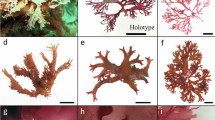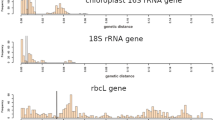Abstract
Species of the marine red algal genus Caloglossa are among taxonomically confuse taxa as a consequence of their widespread phenotypic plasticity. Therefore, in this study, we assessed the specific diversity of Caloglossa from southeastern Brazil by combining both morphological observations and molecular markers. We used cytochrome oxidase subunit I (COI-5P) and partial sequences of ribulose-1,5-bisphosphate carboxylase/oxygenase large subunit (rbcL) gene to investigate 15 taxa of Caloglossa. The four species previously referred to Brazil, C. apomeiotica, C. confusa, C. leprieurii, and C. ogasawaraensis, were also confirmed in this study, and C. rotundata is reported for the first time in the Atlantic Ocean; tetrasporangia are described for the first time for the latter species. Caloglossa confusa has its geographical distribution extended to northeastern Brazil, and C. apomeiotica represents the first record for São Paulo State. Furthermore, the rbcL sequence data indicate that the molecular distinction within the same species ranges from 0 to 5.4%, whereas interspecific divergence ranged between 2.4 and 14.5%, and COI-5P interspecific divergence ranged from 2.5 to 3.3%. The low intraspecific divergence observed (0-0.01%) for COI-5P results from the few samples sequenced.







Similar content being viewed by others
References
Altschul SF, Madden TL, Schäffer AA, Zhang J, Zhang Z, Miller W, Lipman DJ (1997) Gapped BLAST and PSI-BLAST: a new generation of protein database search programs. Nucl Acids Res 25:3389–3402
Cordeiro-Marino M (1978) Rodofíceas bentônicas marinhas do estado de Santa Catarina. Rickia 7:1–243
Ferreira-Correia MM (1987) Rodofíceas marinhas bentônicas do litoral oriental do Estado do Maranhão. Coleção Ciên Bio. Ser Bot 1:1–255
Fortes ACM (1992) Estudo taxonômico e aspectos ecológicos das Rhodophyta do manguezal da Ilha de Santos (complexo estuarino Piauí-Fundo-Real, Sergipe). Dissertação de Mestrado, Universidade Federal Rural de Pernambuco, Recife
Freshwater DW, Ruennes J (1994) Phylogenetic relationships of some European Gelidium (Gelidiales, Rhodophyta) species based upon rbcL nucleotide sequence analysis. Phycologia 33:187–194
Geraldino PJL, Riosmena-Rodriguez R, Liao LM, Boo SM (2010) Phylogenetic relationships within the genus Hypnea (Gigartinales, Rhodophya), with a description of H. caespitosa sp. nov. J Phycol 46:336–345
Guimarães SMPB (2006) A revised checklist of benthic marine Rhodophyta from the State of Espírito Santo, Brazil. Bol Inst Bot 17:143–194
Guindon S, Dufayard JF, Lefort V, Anisimova M, Hordijk W, Gascuel O (2010) New algorithms and methods to estimate maximum-likelihood phylogenies: assessing the performance of PhyML 3.0. Syst Biol 59:307–321
Guiry MD, Guiry GM (2016) AlgaeBase. World-wide electronic publication. National University of Ireland, Galway. http://www.algaebase.org. Accessed 09 Dec 2016
Hall TA (1999) BioEdit: a user-friendly biological alignment editor and analysis program for Windows 95/98/NT. Nucl Acids Symp Ser 41:95–98
Hebert PDN, Cywinska A, Ball SL, deWaard JR (2003) Biological identifications through DNA barcodes. Proc R Soc Lond B 270:313–321
Huelsenbeck JP, Ronquist F (2001) MRBAYES: Bayesian inference of phylogenetic trees. Bioinformatics 17:754–755
Iha C, Milstein D, Guimarães SMPB, Freshwater DW, Oliveira MC (2015) DNA barcoding reveals high diversity in the Gelidiales of the Brazilian southeast coast. Bot Mar 58:295–305
Joly AB (1957) Contribuição ao conhecimento da flora ficológica marinha da Baía de Santos e arredores. Bol Bot Univ São Paulo 14:1–196
Kamiya M, West JA (2014) Cryptic diversity in the euryhaline red alga Caloglossa ogasawaraensis (Delesseriaceae, Ceramiales). Phycologia 53:374–382
Kamiya M, Tanaka J, Hara Y (1995) A morphological study and hybridization analysis of Caloglossa leprieurii (Ceramiales, Rhodophyta) from Japan, Singapore and Australia. Phycol Res 43:81–91
Kamiya M, West JA, King RJ, Zuccarello GC, Tanaka J, Hara Y (1998) Evolutionary divergence in the red algae Caloglossa leprieurii and C. apomeiotica. J Phycol 34:361–370
Kamiya M, Tanaka J, King RJ, West JA, Zuccarello GC, Kawai H (1999) Reproductive and genetic distinction between broad and narrow entities of Caloglossa continua (Delesseriaceae, Rhodophyta). Phycologia 38:356–367
Kamiya M, Zuccarello GC, West JA (2003) Evolutionary relationships of the genus Caloglossa (Delesseriaceae, Rhodophyta) inferred from large-subunit ribosomal RNA gene sequences, morphological evidence and reproductive compatibility, with description of a new species from Guatemala. Phycologia 42:478–497
Kamiya M, Zuccarello GC, West JA (2004) Phylogeography of Caloglossa leprieurii and related species (Delesseriaceae, Rhodophyta) based on the rbcL gene sequences. Jan J Phycol 52:147–151
Kamiya M, West JA, Karsten U, Ganesan EK (2016) Molecular and morphological delineation of Caloglossa beccarii and related species (Delesseriaceae, Rhodophyta). Phycologia 55:640–649
Kano CH, Fujii MT (2016) Caloglossa in Lista de Espécies da Flora do Brasil http://floradobrasil.jbrj.gov.br/jabot/floradobrasil/FB136162. Accessed 04 Jan 2016
King RJ, Puttock CF (1994) Morphology and taxonomy of Caloglossa (Delesseriaceae, Rhodophyta). Aust Syst Bot 7:89–124
Krayesky DM, Norris J, West JA, Fredericq S (2011) The Caloglossa leprieurii-complex (Delesseriaceae, Rhodphyta) in the Americas: the elucidation of overlooked species based on molecular and morphological evidence. Cryptogam Algol 32:37–62
Krayesky DM, Norris JN, West JA, Kamiya M, Viguerie M, Wysor BS, Fredericq S (2012) Two new species of Caloglossa (Delesseriaceae, Rhodophyta) from the Americas, C. confusa and C. fluviatilis. Phycologia 51:513–530
Larkin MA, Blackshields G, Brown NP, Chenna R, McGettigan PA, McWilliam H, Valentin F, Wallace IM, Wilm A, Lopez R, Thompson JD, Gibson TJ, Higgins DG (2007) Clustal W and Clustal X version 2.0. Bioinformatics 23:2947–2948
Lin SM, Fredericq S, Hommersand MH (2001) Systematics of the Delesseriaceae (Ceramiales, Rhodophyta) based on large subunit rDNA and rbcL sequences, including the Phycodryoideae, subfam. nov. J Phycol 37:881–899
Lyra GDM, Costa EDS, Jesus PB, Matos JCG, Caires TA, Oliveira MC, Oliveira EC, Xi Z, Nunes JMDC, Davis CC (2015) Phylogeny of Gracilariaceae (Rhodophyta): evidence from plastid and mitochondrial nucleotide sequences. J Phycol 51:356–366
Milne I, Lindner D, Bayer M, Husmier D, McGuire G, Marshall DF, Wright F (2009) TOPALi v2: a rich graphical interface for evolutionary analyses of multiple alignments on HPC clusters and multi-core desktops. Bioinformatics 25:126–127
Milstein D, Medeiros AS, Oliveira EC, Oliveira MC (2012) Will a DNA barcoding approach be useful to identify Porphyra species (Bangiales, Rhodophyta)? J Appl Phycol 24:837–845
Nauer F, Guimarães NR, Cassano V, Yokoya NS, Oliveira MC (2014) Hypnea species (Gigartinales, Rhodophyta) from the southeastern coast of Brazil based on molecular studies complemented with morphological analyses, including descriptions of Hypnea edeniana sp. nov. and H. flava sp. nov. Eur J Phycol 49:550–575
Nauer F, Cassano V, Oliveira MC (2015) Description of Hypnea pseudomusciformis sp. nov., a new species based on molecular and morphological analyses, in the context of the H. musciformis complex (Gigartinales, Rhodophyta). J Appl Phycol 27:2405–2417
Nunes JMC (2005) Rodofíceas marinhas bentônicas do estado da Bahia, Brasil. Tese de Doutorado, Universidade de São Paulo, São Paulo
Oliveira Filho EC (1969) Algas marinhas do sul do Estado do Espírito Santo (Brasil). I. Ceramiales. Bol Univ São Paulo 343:1–277
Posada D, Crandall KA (1998) MODELTEST: testing the model of DNA substitution. Bioinformatics 14:817–818
Post E (1968) Zur Verbreitungs-Okologie des Bostrychietum. Hydrobiologia 31:241–316
Presting GG (2006) Identification of conserved regions in the plastid genome: implications for DNA barcoding and biological function. Can J Bot 84:1434–1443
Saunders GW (2005) Applying DNA barcoding to red macroalgae: a preliminary appraisal holds promise for future applications. Philos Trans R Soc Biol Sci 360:1879–1888
Saunders GW, Kucera H (2010) An evaluation of rbcL, tufA, UPA, LSU and ITS as DNA barcode markers for the marine green macroalgae. Cryptogam Algol 31:487–528
Saunders GW, McDevitt DC (2012) Methods for DNA barcoding photosynthetic protists emphasizing the macroalgae and diatoms. In: Erickson DL, Kress WJ (eds) DNA barcodes: methods and protocols. Springer, New York, pp 207–222
Sherwood AR, Presting GG (2007) Universal primers amplify a 23S rDNA plastid marker in eukaryotic and cyanobacteria. J Phycol 43:605–608
Soares LP, Gurgel CFD, Fujii MT (2015) Taxonomic reassessment of Gracilaria cearensis (Rhodophyta, Gracilariales), a poorly defined yet common flattened species based on morphological and molecular analysis including topotype collections. Phytotaxa 201:241–255
Swofford DL (2002) PAUP*. Phylogenetic analysis using parsimony (*and other methods). Version 4.0b10. Sinauer Associates, Sunderland
Tamura K, Stecher G, Peterson D, Filipsk A, Kumar S (2013) MEGA6: Molecular evolutionary genetics analysis version 6.0. Mol Biol Evol 30:2725–2729
Thiers B (2016) Index Herbariorum: a global directory of public herbaria and associated staff. New York Botanical Garden’s Virtual Herbarium. http://sweetgum.nygb.org/ih/ (continuously update)
Ugadim Y (1976) Ceramiales (Rhodophyta) do litoral sul do estado de São Paulo e do litoral do estado do Paraná (Brasil). Bol Bot Univ São Paulo 4:133–172
von Martens G (1869) Beiträge zur Algen-Flora Indiens. Flora 52:233–238
West JA, Zuccarello GC, Pedroche FF, Karsten U (1994) Caloglossa apomeiotica sp. nov. (Ceramiales, Rhodophyta) from Pacific Mexico. Bot Mar 37:381–390
Wynne MJ (2011) A checklist of benthic marine algae of the tropical and subtropical western Atlantic: third revision. Nova Hedwig Beih 140:7–166
Yang MY, Macaya EC, Kim (2015) Molecular evidence for verifying the distribution of Chondracanthus chamissoi and C. teedei (Gigartinaceae, Rhodophyta). Bot Mar 58:103–113
Yokoya NS (1996) Controle do desenvolvimento e da morfogênese por auxinas e citocininas em três espécies de rodofíceas: Gracilariopsis tenuifrons, Grateloupia dichotoma, Solieria filiformis. Tese de Doutorado, Universidade de São Paulo, São Paulo
Yoneshigue Y (1985) Taxonomie et ecologie des algues marines dans la region de Cabo Frio (Rio de Janeiro, Brésil). Tese de Doutorado, Universite D´Aix-Marseille, França
Zuccarello GC, Kamiya M, Ootsuki R, Loiseaux de Goer S, Pedroche FF, West JA (2012) New records of red algae from mangroves in El Salvador and Pacific Mexico, combining culture and molecular observations. Bot Mar 55:101–111
Acknowledgements
This work was partially supported by research grants from ‘Fundação de Amparo à Pesquisa do Estado de São Paulo’ (FAPESP, Proc. 2012/18775-6) and the Conselho Nacional de Desenvolvimento Científico e Tecnológico (CNPq, Proc. 484647/2012-1). The first author thanks the Coordenação de Aperfeiçoamento de Pessoal de Nível Superior (CAPES, Proc. 23038.000077/2010-38) for the Master’s dissertation fellowship. MTF thanks CNPq for the Productivity Fellowship (Proc. 303915/2013-7).
Author information
Authors and Affiliations
Corresponding author
Electronic supplementary material
Below is the link to the electronic supplementary material.
Rights and permissions
About this article
Cite this article
Kano, C.H., de Sena, F.S., Cassano, V. et al. Caloglossa species diversity (Delesseriaceae, Rhodophyta) based on morphology and DNA data with emphasis on southeastern Brazil. Braz. J. Bot 40, 551–564 (2017). https://doi.org/10.1007/s40415-016-0360-1
Received:
Accepted:
Published:
Issue Date:
DOI: https://doi.org/10.1007/s40415-016-0360-1




